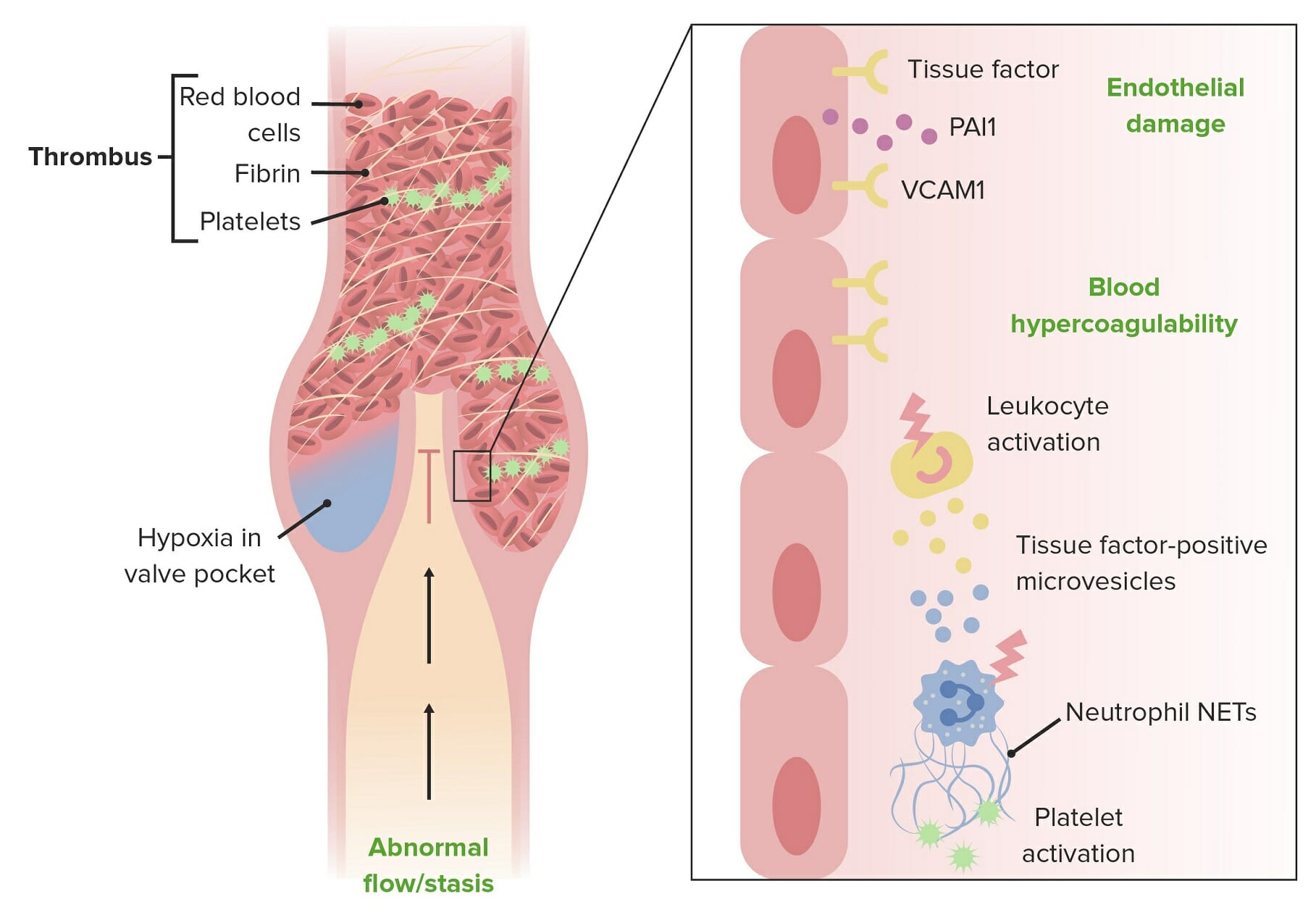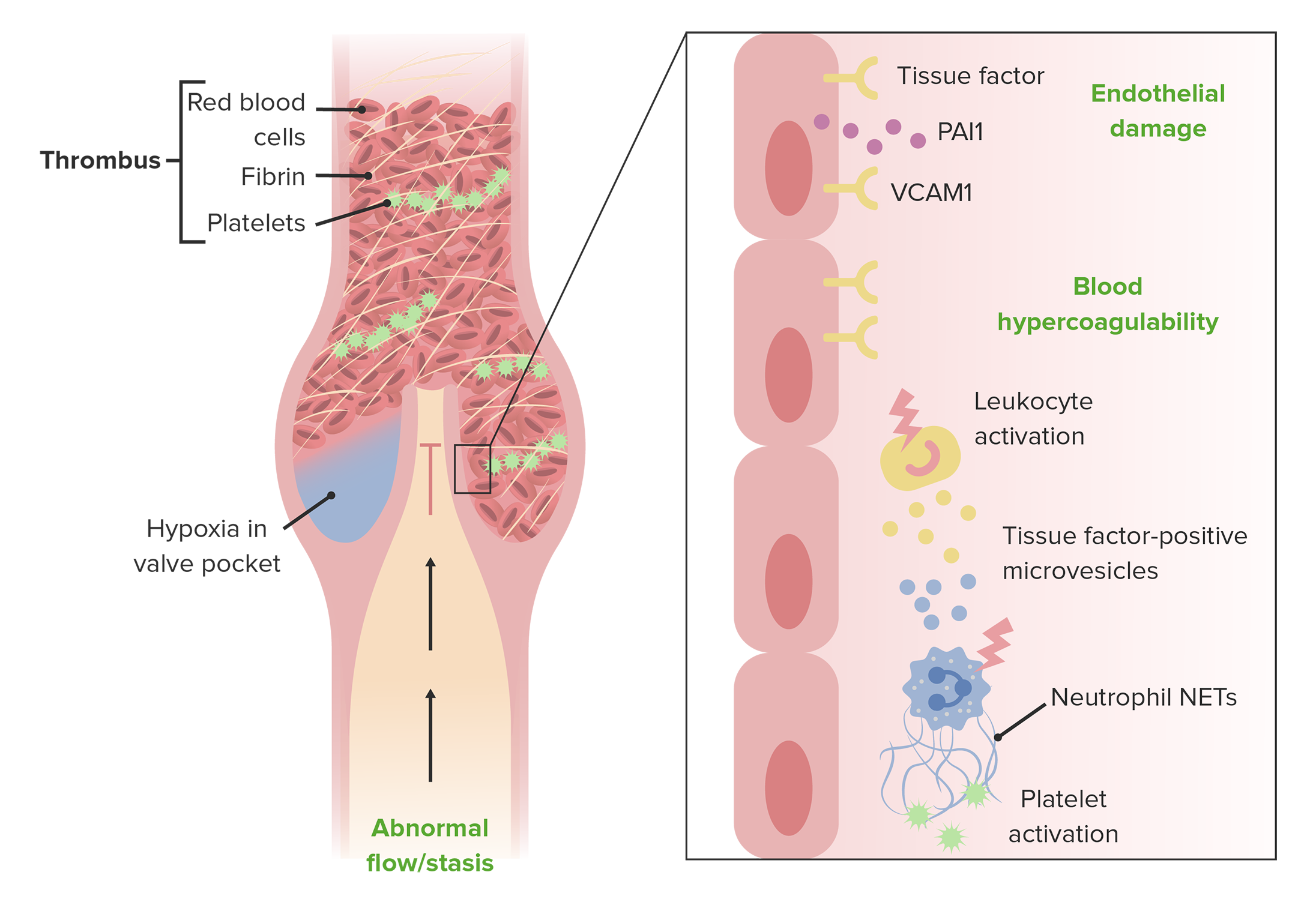Playlist
Show Playlist
Hide Playlist
Deep Vein Thrombosis: Symptoms
-
Slides 10 VascularMedicine advanced.pdf
-
Reference List Vascular Medicine.pdf
-
Download Lecture Overview
00:00 The symptoms: I think we've already talked about these. The symptoms from deep venous thrombosis and pulmonary embolism may be none. 00:10 The patients may be asymptomatic in at least 50%. The inflammatory process in the leg may lead to some discomfort. There may also, of course, be some edema. There may be tenderness when you touch the thigh or the calf. When there's pulmonary embolism, the patients complain of shortness of breath. Heart rate and blood pressure may be abnormal, with a fast heart rate and a low blood pressure. And sometimes, the clot in the lung results in damage to the lung itself, and when that happens, you have a pulmonary infarct. Like a myocardial infarct, it's actually some death of pulmonary tissue, and that results in pain that is pleuritic—that is, it occurs or gets much worse when you take a deep breath. When the patient has a chest pain that they say, "Oh, I can't take a deep breath, because it's going to hurt," that's pleuritic chest pain, and it's due to irritation of the lung and the lining around the lung. The diagnosis: Again, physical exam sometimes helps, although very often, the physical exam is unremarkable. But you may see unilateral—one leg or one ankle has—edema. You may have tenderness when you palpate, or touch, the calf. There may be some redness in the area or warmth. Rarely, you can actually feel a cord from the thrombosed vein. Homan's sign, which is also rare, is when you bend the leg... 01:41 the foot up, and that stretches the gastrocnemius muscle, stretches the vein, and it hurts. 01:48 But it's very rare, and it's not very sensitive or specific, and we really don't do it much anymore. I only put it in here because you may hear about it in your teaching. It's not a very useful physical finding. Unfortunately, the majority of patients with DVT are asymptomatic, and there's nothing on the physical exam that shows you that it's there. So you need instrument-based techniques. One of the clues, by the way, that the patient may be having pulmonary embolism is, as we talked about before, elevated heart rate, increased respiratory rate, normal or lowish blood pressure. And when one checks the carbon dioxide and the oxygen in the blood, they're both low. But these are, again, fairly nonspecific findings that can occur with pneumonia and heart failure. So what are the tests that define and show us that there's DVT? Well, you can actually do an angiogram of the vein, called a venogram, in which you squirt some dye in the vein, and you see areas that… where the dye is not going because there's blood clot there. It's not really used all that often, because we have many excellent noninvasive tests. And it's time-consuming, uses dye, and causes... 03:02 has radiation exposure. Ultrasound is the way, these days, that most cases of DVT are diagnosed. It's low-cost. It's portable. It's noninvasive. And you can see, with an ultrasound, the vein can't be compressed because there's clot in it. You can sometimes actually see clot in the vein, and with a Doppler, you can see that there's decreased flow in the vein. There's a blood test, which is a breakdown product of a clot in the vascular system, called D-dimer. And when that's elevated, it suggests that there's clotting going on intravascularly. There is a test that measures the volume change within the leg, called plethysmography. 03:46 This test was more popular in the past, but not so much now. And of course, CT and MRI can also show this. So let's talk a little bit more about the ultrasound test. It has two components. First of all, there's a color-flow Doppler that shows us when flow in the vein is abnormal. It takes about 45 minutes to do that. Another test that we do with that is we look at the vein. We look for clot in the vein channel, and then you try and squeeze the calf and see whether the vein collapses. It should collapse when you squeeze the calf. If the vein doesn't collapse, it usually means that there's a clot in there, because a normal vein should collapse nicely. It is of interest that clots that are in the popliteal vein or below usually don't embolize, and they're usually very small. But they can propagate. They can increase in size, and so if you see some clot in the popliteal vein, you need to redo the ultrasound scan again three to five days later, because the clot may have increased in size, thus making it much higher risk for pulmonary embolism. And again, as I mentioned, the clot's identified by failure of the vein to collapse when you squeeze it, and the duplex ultrasound and the limited compression are really very good tests for diagnosing DVT. And this… these figures are not easily seen, but on the one on the left one, actually, there is a clot in the vein, and the one on the right, there is failure of the vein to com… to collapse when the calf is squeezed. There are a number of little tricks of the trade. A good technician—a good ultrasound deep venous thrombosis technician—can, as I said, see augmentation of flow when they compress the calf, and also, they look to see if there's collapse of the vein when they squeeze it. You can adjust the gain—that is, how bright the image is—so you get a better view of the vascular system. And again, if there's plus–minus findings, you can do the other side to see if it looks normal compared to the side that you're thinking has DVT. So there are a number of little tricks that a very good ultrasound technician is very accurate in finding deep venous thrombosis with its potential for thromboembolism.
About the Lecture
The lecture Deep Vein Thrombosis: Symptoms by Joseph Alpert, MD is from the course Venous Diseases.
Included Quiz Questions
Which of the following techniques is NOT used to diagnose deep venous thrombosis?
- Chest X-ray.
- Doppler ultrasound.
- Physical exam.
- Venography.
Elevated heart rate, low CO2 and O2 in blood, increased respiratory rate are seen in DVT, but can also been seen in which pathology?
- Pneumonia.
- Cholera.
- Atrial fibrillation.
- Botulism.
- Tetanus.
Customer reviews
5,0 of 5 stars
| 5 Stars |
|
5 |
| 4 Stars |
|
0 |
| 3 Stars |
|
0 |
| 2 Stars |
|
0 |
| 1 Star |
|
0 |





